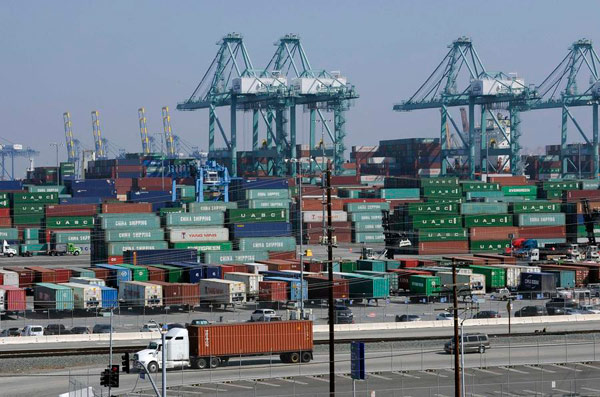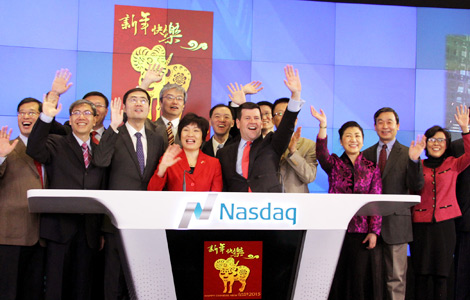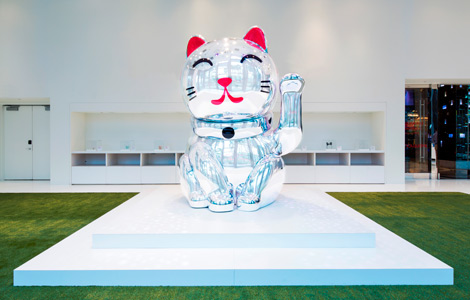California port chief upbeat on agreement to end dock strike
Updated: 2015-02-20 05:50
By PAUL WELITZKIN in New York(China Daily USA)
|
||||||||
 |
|
Cargo containers sit idle at the Port of Los Angeles as a back-log of over 30 container ships sit anchored outside the Port in Los Angeles, California, Feb 18, 2015. US Labor Secretary Tom Perez planned to hold a second round of talks with shipping company executives and union leaders for 20,000 dock workers on Wednesday, seeking to broker a deal to end months of labor turmoil clogging cargo traffic at 29 West Coast ports.[Photo/Agencies] |
The chief executive of the Port of Long Beach in California, a leading gateway for trade between the United States and Asia, said he thinks union leaders and shipping executives are close to reaching a new contract to end a dispute that has stalled cargo traffic at 29 West Coast ports.
US Labor Secretary Tom Perez joined talks this week with union leaders representing 20,000 dockworkers and the shipping executives.
“I think we are close to seeing these groups reach an agreement on a new contract,” Jon Slangerup of the Long Beach port told China Daily on Thursday.
Asian cargo represents 97 percent of the merchandise and products that move through Long Beach with 50 percent of that coming from China, according to Slangerup. Over 7 million containers a year are shipped to and from the port along with $180 billion worth of wholesale goods.
A combination of a work slowdown initiated by dockworkers in November, shipping companies limiting the loading and unloading of vessels to daytime shifts to avoid paying overtime and problems involving moving large amounts of cargo from bigger ships have combined to create a backlog of merchandise and containers.
“The labor talks went sideways in November,” said Slangerup. “The labor problems prevented us from digging out from the congestion.”
Slangerup said this is the first year of an alliance among the ocean carriers that saw the number of containers on vessels increase to nearly 14,000 a ship from about 8,00. The containers are at least 20 feet long and in many cases up to 40 feet.
A change in the way ships were loaded also contributed to the dispute. The ships used to be loaded so that containers destined for a specific location in the US were grouped together and then unloaded and sent off for further shipping. Slangerup said the containers are now randomly loaded on ships forcing port workers to handle the cargo several times instead of once or twice.
“We are on a learning curve and I think we will have this worked out in a few months,” he said.
The port –owned by the City of Long Beach - has over 30,000 employees and provides for about 1 out of 8 jobs in Long Beach, Slangerup said. It has a long history with China. In 1981, the China Ocean Shipping Co designated it as its first US port of call.
Slangerup said manufactured goods including automobiles, machinery parts, furniture and apparel represent the bulk of the cargo that comes through Long Beach. “We get a lot of cars through here. Toyota brings in vehicles from Japan and Mercedes from Germany. Mercedes comes here because we are the fastest outlet for products that need to be distributed in the western US,” he added.
Exports at the port had been growing but because of the stronger US dollar, they have started to decline slightly Slangerup said.
paulwelitzkin@chinadailyusa.com

 Tibetans rejoice at twin New Year celebration
Tibetans rejoice at twin New Year celebration
 Across America over the week (from Feb 13 to 19)
Across America over the week (from Feb 13 to 19)
 Chinese in the South remembered
Chinese in the South remembered
 Ringing in Chinese New Year on the Nasdaq
Ringing in Chinese New Year on the Nasdaq
 Spring Festival greetings from the ambassadors
Spring Festival greetings from the ambassadors
 Las Vegas lights up for Lunar New Year
Las Vegas lights up for Lunar New Year
 Spring Festival fireworks in New York City
Spring Festival fireworks in New York City
 Going abroad for Lunar New Year
Going abroad for Lunar New Year
Most Viewed
Editor's Picks

|

|

|

|

|

|
Today's Top News
Chinese students, faculty to study at Missouri university
Phillips Academy Andover to deepen China ties
Chinese in the South remembered
California port chief upbeat on agreement to end dock strike
NBA China CEO sees the sport proliferate
China tilts to Kabul with US pullout
No letup seen for business travel
Chinese visitors set to celebrate New Year worldwide
US Weekly

|

|







